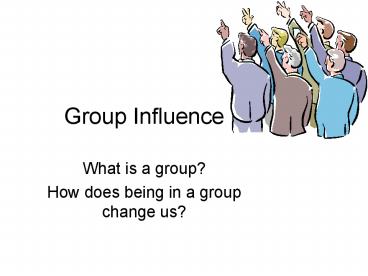Group Influence PowerPoint PPT Presentation
1 / 10
Title: Group Influence
1
Group Influence
- What is a group?
- How does being in a group change us?
2
What is a group?
- Numerous definitions of the term.
- A number of individuals who are interacting with
each other. - Several individuals who are interdependent in
some way. - A number of individuals who join together to
achieve a goal. - A social unit consisting of two or more people
who perceive themselves as belonging to a group. - A collection of individuals whose interactions
are structured by a set of roles and norms.
3
Different Forums of Group Influence
- Collective influence in minimal group situations
- Social facilitation
- Social Loafing
- Deindividuation
- Group influence in interacting groups
- Group polarization
- Groupthink
- Minority Influence
4
Social Facilitation
- The strengthening of dominant responses in the
presence of others. - Why?
- Evaluation Apprehension enhancement is strongest
when people think they are being evaluated. - Mere presence occurs in other species, may be a
built-in biological mechanism.
5
Social Loafing
- Tendency to reduce effort when pooling effort
toward a common goal and when they are not
individually accountable. - Tug of war, clapping studies.
- In essence, social loafing appears to occur due
to a reduction in evaluation apprehension. - Increases when not individually evaluated or
rewarded. - Decreases when tasks are challenging or
appealing, and when fellow group members are
friends (as opposed to strangers).
6
Deindividuation
- Loss of self-awareness and evaluation
apprehension. - Factors
- Physical anonymity (Zimbardo study with masked
women delivering shocks, drivers in convertibles
are less likely to honk, anthropological research
that suggests that cultures with depersonalized
warriors also were the cultures more likely to
brutalize enemies).
7
Deindividuation
- However, deindividuation does not automatically
lead to negative behavior. - Makes one more responsive to cues in the
environment, thus altruistic cues lead a
deindividuated person to be kinder. - Why?
- Diminished self-awareness those made self-aware
exhibit more self-control and their actions are
more consistent with their attitudes.
8
Group Polarization
- Originally dubbed the risky shift
- The risky shift involved the tendency for group
decisions to be riskier than the average decision
of the individuals in the group. - However, subsequent research showed that groups
may get more cautious - Group polarization is the tendency for group
decisions to be more extreme than that of
individuals. Amplifies pre-existing tendencies. - Same logic as social facilitation.
9
Group Polarization
- Why?
- Group discussion leads you to hear more
information. - Active participation in a discussion leads you to
rehearse your thoughts leading to more attitude
change. - Safer to provide more extreme answers once the
normative opinion of the group has been
determined.
10
Minority Influence and Leadership
- What makes someone a good leader?
- Theories
- Trait Theory/Great Leader Charisma,
intelligence? - Social Determinism.
- Fiedlers Contingency Theory person vs. task
oriented leaders.

